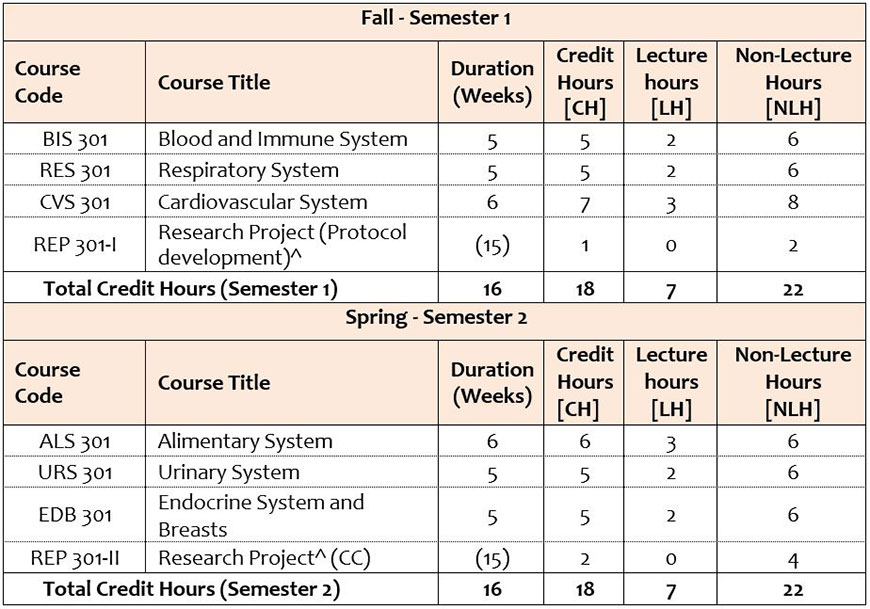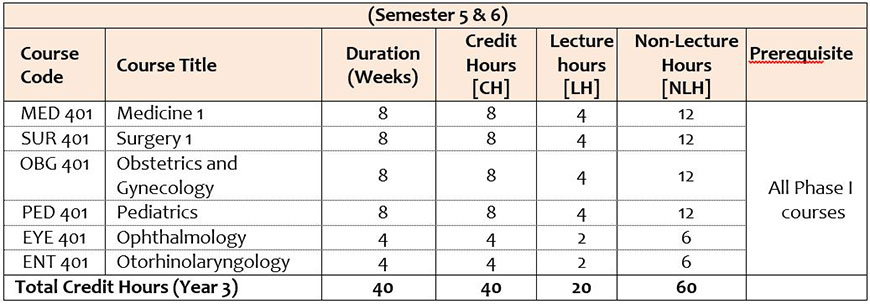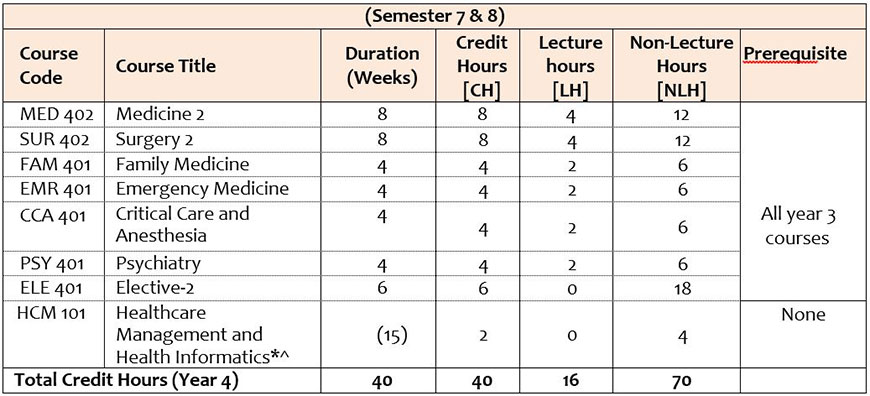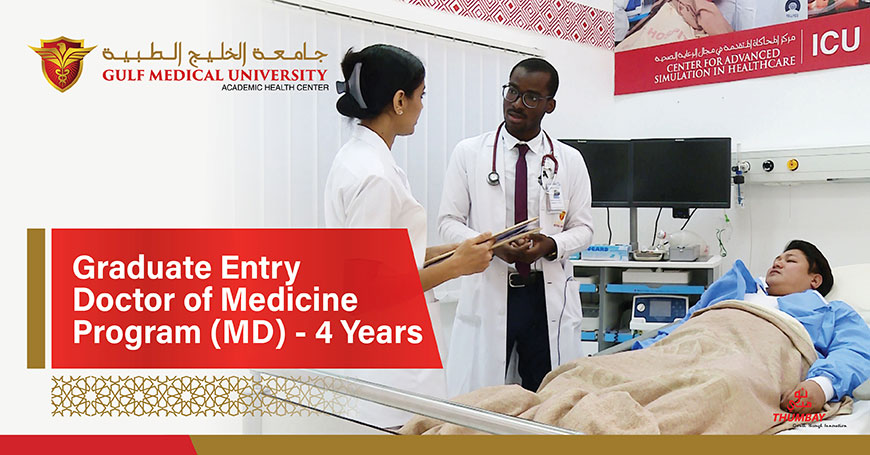Credit:The credit equivalence of the 4-Year Doctor of Medicine Program is 152 credits.
Study Plan
Phase I (Core Medical Sciences)
Year 1

CC Course Continued
^Parallel courses in the semester
Credit Hour calculation: 1 Credit = 1 hour of Lecture/week or 2 hours of Lab or Activity (PBL, VPL, Seminar etc.)/week for 15 weeks.
Year 2

^Parallel courses in the semester.
CC: Course Continued
#Work Based Learning: 90 clinical contact hours to be completed during year 2 of the program
#Elective-1: 90 clinical contact hours to be completed during year 2 of the program OR students can opt to do research.
Credit Hour calculation: 1 Credit = 1 hour of Lecture/week or 2 hours of Lab or Activity (PBL, VPL, Seminar, etc.)/week or 3-4 hours of clinical posting/week for 15 weeks.
Phase II (‘Transition to Practice’ or Clerkships)
Year 3

Year 4

*General Education Course; ^Parallel courses in the semester.Credit Hour calculation: 1 Credit = 1 hour of Lecture/week or 2 hours of Lab or Activity (PBL, VPL, Seminar, etc.)/week or 3 hours of clinical posting/week for 15 weeks
Summary

Course Descriptions
Phase I G MD Program
BIS 301 Blood and I mmune S ystem
The contents of the Blood and Immune System course form the ‘core knowledge for practice’ in which prevalent and important clinical problems/presentations in the community are identified through a patient-centered approach. This course focuses on the etiology, pathophysiology, investigations, behavioral and ethical aspects, principles of prevention and management of common disorders of the Blood and Immune system using a multidisciplinary integrated approach. The course builds on the previous knowledge of normal structure, function, and general pathology mechanisms of disease learnt in Phase I. Problem-based Learning and Virtual-Patient Learning using high-fidelity Artificial Intelligence-based simulated patients constitutes the primary strategy of learning and teaching. Students also learn common clinical skills related to the system and interpret results of investigations in clinical skills sessions to prepare them for the clerkship phase.
RES 301 Respiratory S ystem
The contents of the Respiratory System course form the ‘core knowledge for practice’ in which prevalent and important clinical problems/presentations in the community are identified through a patient-centered approach. This course focuses on the etiology, pathophysiology, investigations, behavioral and ethical aspects, principles of prevention and management of common disorders of the Respiratory System using a multidisciplinary integrated approach. The course builds on the previous knowledge of normal structure, function, and general pathology mechanisms of disease learnt in Phase I. Problem-based Learning and Virtual-Patient Learning using high-fidelity Artificial Intelligence-based simulated patients constitutes the primary strategy of learning and teaching. Students also learn common clinical skills related to the system and interpret results of investigations in clinical skills sessions to prepare them for the clerkship phase.
CVS 301 Cardiovascular System
The contents of the Cardiovascular System course form the ‘core knowledge for practice’ in which prevalent and important clinical problems/presentations in the community are identified through a patient-centered approach. This course focuses on the etiology, pathophysiology, investigations, behavioral and ethical aspects, principles of prevention and management of common disorders of the Cardiovascular System using a multidisciplinary integrated approach. The course builds on the previous knowledge of normal structure, function, and general pathology mechanisms of disease learnt in Phase I. Problem-based Learning and Virtual-Patient Learning using high-fidelity Artificial Intelligence-based simulated patients constitutes the primary strategy of learning and teaching. Students also learn common clinical skills related to the system and interpret results of investigations in clinical skills sessions to prepare them for the clerkship phase.
REP 301 Research Project
This course running over 3 semesters provides students the opportunity to conduct quality research under faculty guidance. Students will develop a group research proposal in the third year [fall semester], collect and analyze the data in spring semester of the same year, and present the research findings in fourth year [fall semester]. This will enable students to integrate the knowledge, skills, and competencies acquired in Research Methodology and Biostatistics course in year 2 with the clinical knowledge and skills to conduct research in the community or in an institutional setting. The students will develop needed research competency to collect, analyze, interpret, and present data, taking into consideration all ethical and legal requirements. The course will enable student to apply critical thinking, communication, and analytic skills during various steps of research. An online certificate on ‘Research Ethics and Good Clinical Practice’ must be obtained before starting the study.
ALS 301 Alimentary System
The contents of the Alimentary System course form the ‘core knowledge for practice’ in which prevalent and important clinical problems/presentations in the community are identified through a patient-centered approach. This course focuses on the etiology, pathophysiology, investigations, behavioral and ethical aspects, principles of prevention and management of common disorders of the Alimentary System using a multidisciplinary integrated approach. The course builds on the previous knowledge of normal structure, function, and general pathology mechanisms of disease learnt in Phase I. Problem-based Learning and Virtual-Patient Learning using high-fidelity Artificial Intelligence-based simulated patients constitutes the primary strategy of learning and teaching. Students also learn common clinical skills related to the system and interpret results of investigations in clinical skills sessions to prepare them for the clerkship phase.
URS 301 Urinary System
The contents of the Urinary System course form the ‘core knowledge for practice’ in which prevalent and important clinical problems/presentations in the community are identified through a patient-centered approach. This course focuses on the etiology, pathophysiology, investigations, behavioral and ethical aspects, principles of prevention and management of common disorders of the Urinary System using a multidisciplinary integrated approach. The course builds on the previous knowledge of normal structure, function, and general pathology mechanisms of disease learnt in Phase I. Problem-based Learning and Virtual-Patient Learning using high-fidelity Artificial Intelligence-based simulated patients constitutes the primary strategy of learning and teaching. Students also learn common clinical skills related to the system and interpret results of investigations in clinical skills sessions to prepare them for the clerkship phase.
EDB 301 Endocrine System and Breast s
The contents of the Endocrine System and Breasts course form the ‘core knowledge for practice’ in which prevalent and important clinical problems/presentations in the community are identified through a patient-centered approach. This course focuses on the etiology, pathophysiology, investigations, behavioral and ethical aspects, principles of prevention and management of common disorders of the Endocrine System and Breasts using a multidisciplinary integrated approach. The course builds on the previous knowledge of normal structure, function, and general pathology mechanisms of disease learnt in Phase I. Problem-based Learning and Virtual-Patient Learning using high-fidelity Artificial Intelligence-based simulated patients constitutes the primary strategy of learning and teaching. Students also learn common clinical skills related to the system and interpret results of investigations in clinical skills sessions to prepare them for the clerkship phase.
RPS 301 Reproductive System
The contents of the Reproductive System course form the ‘core knowledge for practice’ in which prevalent and important clinical problems/presentations in the community are identified through a patient-centered approach. This course focuses on the etiology, pathophysiology, investigations, behavioral and ethical aspects, principles of prevention and management of common disorders of the Reproductive System using a multidisciplinary integrated approach. The course builds on the previous knowledge of normal structure, function, and general pathology mechanisms of disease learnt in Phase I. Problem-based Learning and Virtual-Patient Learning using high-fidelity Artificial Intelligence-based simulated patients constitutes the primary strategy of learning and teaching. Students also learn common clinical skills related to the system and interpret results of investigations in clinical skills sessions to prepare them for the clerkship phase.
MSS 301 Musculoskeletal System and Skin
The contents of the Musculoskeletal System and Skin course form the ‘core knowledge for practice’ in which prevalent and important clinical problems/presentations in the community are identified through a patient-centered approach. This course focuses on the etiology, pathophysiology, investigations, behavioral and ethical aspects, principles of prevention and management of common disorders of the Musculoskeletal System and Skin using a multidisciplinary integrated approach. The course builds on the previous knowledge of normal structure, function, and general pathology mechanisms of disease learnt in Phase I. Problem-based Learning and Virtual-Patient Learning using high-fidelity Artificial Intelligence-based simulated patients constitutes the primary strategy of learning and teaching. Students also learn common clinical skills related to the system and interpret results of investigations in clinical skills sessions to prepare them for the clerkship phase.
NES 301 Nervous System
The contents of the Nervous System course form the ‘core knowledge for practice’ in which prevalent and important clinical problems/presentations in the community are identified through a patient-centered approach. This course focuses on the etiology, pathophysiology, investigations, behavioral and ethical aspects, principles of prevention and management of common disorders of the Nervous system using a multidisciplinary integrated approach. The course builds on the previous knowledge of normal structure, function, and general pathology mechanisms of disease learnt in Phase I. Problem-based Learning and Virtual-Patient Learning using high-fidelity Artificial Intelligence-based simulated patients constitutes the primary strategy of learning and teaching. Students also learn common clinical skills related to the system and interpret results of investigations in clinical skills sessions to prepare them for the clerkship phase.
IMS 301 Integrated Multisystem Course
The contents of the Integrated Multisystem course form the ‘core knowledge for practice’ in which prevalent and important clinical problems/presentations in the community are identified through a patient-centered approach. The integrated multisystem course offers opportunities to integrate between and beyond the organ-systems. The course will be structured around a series of cases which are multisystem in nature using Virtual-Patient Learning and Problem-Based Learning. The students will learn how to present case studies by following an evidence-based approach, helping them to acquire critical thinking and problem-solving skills. It will also offer opportunities to review and reinforce concepts learnt in individual organ-systems to prepare them for the Phase II exit examination and to be engaged in Phase III “transition to practice”.
WBL 301 Work Based Learning
The module is offered as 90 contact hours of clinical postings at designated clinical posting sites. The Work-based Learning course provides excellent opportunities for students to apply and perform the skills like history taking and physical examination learnt in the simulated setting (during the skills sessions in each organ-system course) on real patients under supervision, and observe the clinicians interact with the patients in the ambulatory care and inpatient settings. They will also appreciate the role of teamwork in providing care to the patient and introduction to the different healthcare systems. This course prepares the students for a smooth transition to the clinical years.
ELE 301 Elective-1
Elective-1 posting serves to promote the application of professional skills in the practice of medicine in different healthcare systems, develop confidence, maturity, responsibility and interpersonal skills in novel settings, and demonstrate a greater understanding of ethical, confidential and sensitive issues when exposed to patients with different beliefs, values and culture. The students can opt for any specialty including research at any recognized site (teaching hospitals) either within or outside the country. GMU has collaboration with several national and international universities and teaching hospitals to facilitate placement of students.
AHP 102: Arabic for Healthcare Professionals
The Arabic for Health Professionals course is designed to enable students to communicate in health professional settings. The course will enable non-native speakers to acquire basic Arabic terms used in greetings and simple communication with patients. Peer-Assisted Learning helps the student to learn Arabic terminology related to the organ-system. The content of the course is integrated into the organ-system courses.
EIS 102 Entrepreneurship, Innovation and Sustainability
This course aims to initiate the innovative thinking process among the students, enable them with basic entrepreneurship skills, and make them understand the concepts of sustainability in the modern world in the field of their future profession. The course is designed in 3 parts in order to explain the main principles of the entrepreneurial process; to link them with the concept of innovation and to engage in sustainability leadership to affect positive societal change. For future medical professionals, this course has to ensure the ability of medical decision-making is properly balanced between professional, and ethical approaches on one side and finance and business on the other side.
AIH 101 Artificial Intelligence for Healthcare Professionals
Artificial Intelligence for Healthcare Professions is an intermediate level course which falls under the Technology Sciences domain for healthcare professionals. The course examines the evolution of AI, the conceptual development of AI techniques, such as machine learning, deep learning, data sciences, and comprehensively covers data security, privacy, as well as the social and legal implications of AI in healthcare. The learner will explore the benefits of AI’s application in healthcare – which will prepare future health practitioners to successfully collaborate with AI and data science experts in an immersive AI-based healthcare environment.
Phase II G MD Program
MED 401 Medicine 1
The clerkship in Medicine 1 in Year 5 is designed to give the student a broad exposure to common medical conditions in clinical practice. The student will learn to take a relevant history, perform a general and focused systemic examination, formulate differential diagnoses, and develop a plan to manage common acute and chronic medical disorders in ambulatory and inpatient settings. This clerkship lays the foundation for the Medicine 2 clerkship in Year 6.
SUR 401 Surgery 1
The clerkship in Surgery 1 in Year 5 is designed to give the student a broad exposure to the principles of diagnosis and management of common surgical problems, including surgical emergencies. It provides the students with adequate clinical encounters in ambulatory, bedside and OR settings. During the rotation, the student will be expected to focus on basic principles of peri-operative, operative, and postoperative management of the patient with a surgical problem. This clerkship lays the foundation for the clerkship in Surgery 2 clerkship in Year 6.
OBG 401 Obstetrics and Gynecology
The clerkship in Obstetrics and Gynecology is designed to give the student a broad exposure to the principles of diagnosis and management of common gynecologic and obstetric conditions in the ambulatory care, delivery room, operation room and inpatient settings. The procedural skills like delivering a baby, taking a PAP smear, pelvic assessment is also learnt and practiced in the safe environment of the simulation lab.
PED 401 Pediatrics
The clerkship in Pediatrics is designed to give the student a broad exposure to common pediatric conditions in ambulatory care, intensive care and inpatient settings. The student will assess the normal growth and development of a child and learn to obtain clinical history in an age-appropriate and sensitive manner from a child and or the accompanying adult and conduct a physical examination appropriate to the condition and interpret the clinical findings. The student will be able to interpret lab results to suggest a diagnosis and discuss the management of the disease.
EYE 401 Ophthalmology
The clerkship in Ophthalmology is designed to give the student a broad exposure to common ophthalmology conditions in ambulatory care, operative and inpatient settings, and indications for referral of cases to ophthalmologists. The student will learn to take an ophthalmic history and perform a basic eye examination to detect common eye abnormalities, interpret clinical findings, arrive at a diagnosis, and discuss the management plan. The students will also observe ophthalmic investigative procedures and surgeries performed by the faculty.
ENT 401 Otorhinolaryngology
The clerkship in Otorhinolaryngology is designed to give the student a broad exposure to common conditions in ambulatory care, operative and inpatient settings related to ear, nose, and throat diseases. The student will obtain history and perform a basic head and neck examination with appropriate equipment. The students will discuss the clinical findings, diagnose common ENT problems, and design a treatment plan. The students will also observe common ENT surgeries performed by the faculty.
MED 402 Medicine 2
Medicine II clerkship is built upon the knowledge and competencies gained in Medicine 1 clerkship in year 5. The students are rotated in medical sub-specialties like neurology, nephrology, dermatology, and cardiology. This clerkship is designed for medical students to gain additional experience in clinical presentation and management of medical conditions. This clerkship emphasizes integrated patient care, teamwork, and preparing the student for internship and professional practice.
SUR 402 Surgery 2
Surgery 2 clerkship is built upon the knowledge and competencies gained in Surgery 1 clerkship in year 5. The students are rotated in surgical subspecialties of Trauma and acute care, Orthopedics and Urology. This clerkship is designed for medical students to acquire additional knowledge and skills to provide appropriate levels of care under supervision for commonly encountered surgical diseases. This clerkship emphasizes integrated patient care, teamwork, and preparing the student for internship and professional practice.
FAM 401 Family Medicine
This clerkship provides the learners with an insight into the continuing and comprehensive medical care for individuals and their families. It differs from other specialties because it encompasses all ages, genders, organ-systems, and every disease entity. The heart of this clerkship is the patient-physician relationship viewed in the context of the patient’s family. The student will spend most of their time in the primary care settings, where they will clerk patients and their families under the supervision of faculty.
EMR 401 Emergency Medicine
The emergency room rotation offers a special environment and an opportunity to practice fundamental skills of decision making in an acute care setting. The aim of the posting is for the learner to develop critical thinking and multi-tasking skills in a busy ER facility, understand the concept of acute care, patient transfer, and develop good communication skills and professional interaction with the patients, relatives, and other medical personnel.
CCA 401 Critical Care and Anesthesia
The posting in the critical care areas of ICU and CCU is designed to provide the students with practical knowledge about the management of critically ill patients. Students get opportunities to improve their bedside clinical skills, including focused history taking, clinical examination, relevant investigations, and appropriate treatment relevant to the acute critically ill patient, master the essential emergency life support and resuscitation skills, and develop the habit of good communication skills and professional interaction with the patient’s and other medical personnel including breaking bad news. The anesthesia clerkship will expose the students to basic principles of anesthesia induction, maintenance, recovery, and postoperative care. This will also support the basic life support skills of the student.
PSY 401 Psychiatry
This clerkship will provide the medical student with experience in evaluating and treating patients with various mental illnesses. Students will be exposed to all age groups including children, adolescents, adults, families, and geriatric patients with emphasis on understanding cultural issues in mental health. The clerkship will also stimulate a holistic thinking process in the medical student, initiating awareness of the biopsychosocial model of diseases in patients. The overall aim of the rotation is to give students a broad view of the spectrum of mental health problems.
ELE 401 Elective– 2
Elective 2 posting in year 6 serves to promote the application of professional skills in the practice of medicine in different healthcare systems prior to graduation, develop confidence, maturity, responsibility, and interpersonal skills in novel settings, and demonstrate a greater understanding of ethical, confidential, and sensitive issues when exposed to patients with different beliefs, values and culture. The student is encouraged to pursue the electives either in the country or abroad in any medical specialty, including research or healthcare management.
HCM 101 Healthcare Management and Health Informatics
Healthcare management course trains the student to advocate quality patient healthcare and learn how the interaction between different departments of the hospital works together to provide patient care. There is an emphasis on different aspects of patient safety and quality, which are incrementally built up in this course.
This course also introduces the students to Health Informatics, which would enable them to use the Health Information System (HIS) of the hospital and learn the process of accessing and sharing medical information with stakeholders.












